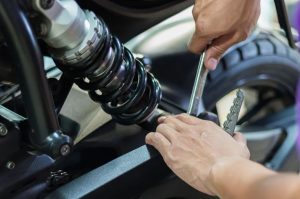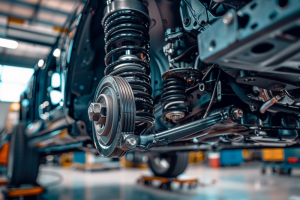Suspension springs are among the most critical yet overlooked components of a vehicle’s suspension system. They support the weight of the car, absorb road shocks, maintain proper ride height, and ensure stable handling. Despite their durability, springs are constantly under stress — from heavy loads, road conditions, weather changes, and daily wear and tear. Without proper maintenance, they can weaken or fail prematurely, compromising ride comfort, safety, and even damaging other suspension components.
In this guide, we’ll explain how to care for your suspension springs, the warning signs of wear, and the steps you can take to maximize their service life.
Why Suspension Spring Maintenance Matters

Many drivers assume that suspension springs last the lifetime of the vehicle — but this isn’t always the case. Road salt, moisture, aggressive driving, and heavy loads can significantly reduce their lifespan. Proper maintenance not only extends spring life but also:
-
Improves ride comfort and stability
-
Reduces wear on shock absorbers and struts
-
Helps maintain proper alignment and tire contact
-
Prevents costly suspension repairs
Key Factors That Affect Spring Longevity
Understanding what shortens a spring’s life can help you take preventive action. Here’s a quick overview:
| Factor | Impact on Springs | Preventive Action |
|---|---|---|
| Corrosion | Rust weakens the spring metal and leads to cracks or breakage | Regular cleaning and anti-rust coating |
| Overloading | Excess weight compresses springs beyond their design limit | Avoid carrying loads above vehicle capacity |
| Poor Road Conditions | Frequent potholes and uneven surfaces accelerate wear | Drive carefully and at reduced speeds |
| Temperature Extremes | Expansion and contraction can fatigue metal over time | Regular inspection in seasonal changes |
| Lack of Maintenance | Dirt, debris, and neglect reduce spring performance | Scheduled cleaning and inspections |
Step-by-Step Suspension Spring Maintenance Tips
1. Clean Springs Regularly
Dirt, mud, and especially road salt can accumulate on springs, causing corrosion. Wash your suspension components when cleaning the undercarriage — especially in winter or after off-road driving.
-
Use a pressure washer or hose to remove debris.
-
For stubborn rust spots, gently brush and apply a rust inhibitor.
2. Inspect for Damage and Wear
Visual inspection should be part of every major service or at least twice a year. Look for:
-
Cracks or fractures
-
Uneven gaps or sagging
-
Rust patches or flaking metal
Pro Tip: Check for ride height differences between corners — a sagging side often signals a failing spring.
3. Lubricate Mounting Points
Although the springs themselves don’t need lubrication, the mounts and seats can benefit from it. Proper lubrication prevents noise, reduces vibration, and minimizes wear on contact points.
4. Avoid Overloading the Vehicle
Exceeding the load capacity puts excessive stress on the suspension system. Check your vehicle’s Gross Vehicle Weight Rating (GVWR) and avoid carrying loads above the recommended limit. If you frequently transport heavy cargo, consider upgrading to heavy-duty or reinforced springs.
5. Address Suspension Problems Early
Springs rarely fail in isolation. If you notice clunking noises, uneven ride height, or increased bouncing, the problem could also involve shock absorbers, struts, or bushings. Replacing worn components promptly reduces additional strain on the springs.
Seasonal Maintenance: Adapting to Conditions
Your maintenance approach should change slightly with the seasons:
| Season | Maintenance Focus | Reason |
|---|---|---|
| Winter | Wash off road salt and apply rust protectant | Prevent corrosion from salt and moisture |
| Spring | Inspect for rust and damage after cold weather | Temperature changes can cause fatigue |
| Summer | Check for sagging or heat damage | Heat can affect metal elasticity |
| Autumn | Inspect after summer trips or heavy loads | Prevent early wear before winter |
Common Signs Your Springs Need Replacement
Even with regular maintenance, springs eventually wear out. Watch for these signs:
-
Uneven ride height – One side of the car sits lower.
-
Excessive bouncing – Poor damping and reduced stability.
-
Clunking or knocking noises – Often from a broken or loose spring.
-
Vehicle leaning in turns – Compromised spring strength.
-
Premature tire wear – Suspension misalignment from sagging springs.
If any of these symptoms appear, it’s best to inspect the suspension immediately. Continuing to drive with weak or broken springs can damage shock absorbers, tires, and even chassis components.
Pro Tips to Maximize Spring Lifespan

-
Inspect during every oil change: Quick checks can catch early signs of damage.
-
Use rust-resistant coatings: Especially important in humid or winter climates.
-
Upgrade for specific use cases: Heavy-duty springs for towing or reinforced options for off-road vehicles.
-
Replace in pairs: Always replace springs on both sides of the axle to maintain balance and performance.
Conclusion
Suspension springs might seem like simple components, but their condition directly impacts ride comfort, handling, safety, and even fuel efficiency. With proper care — regular cleaning, careful loading, seasonal checks, and prompt repairs — you can significantly extend their lifespan and avoid costly suspension overhauls.
If your springs are already showing signs of wear or damage, don’t wait until they fail. High-quality replacements can restore your vehicle’s performance and reliability. You can easily Buy Springs & Components online to ensure a smooth and safe ride for many miles ahead.